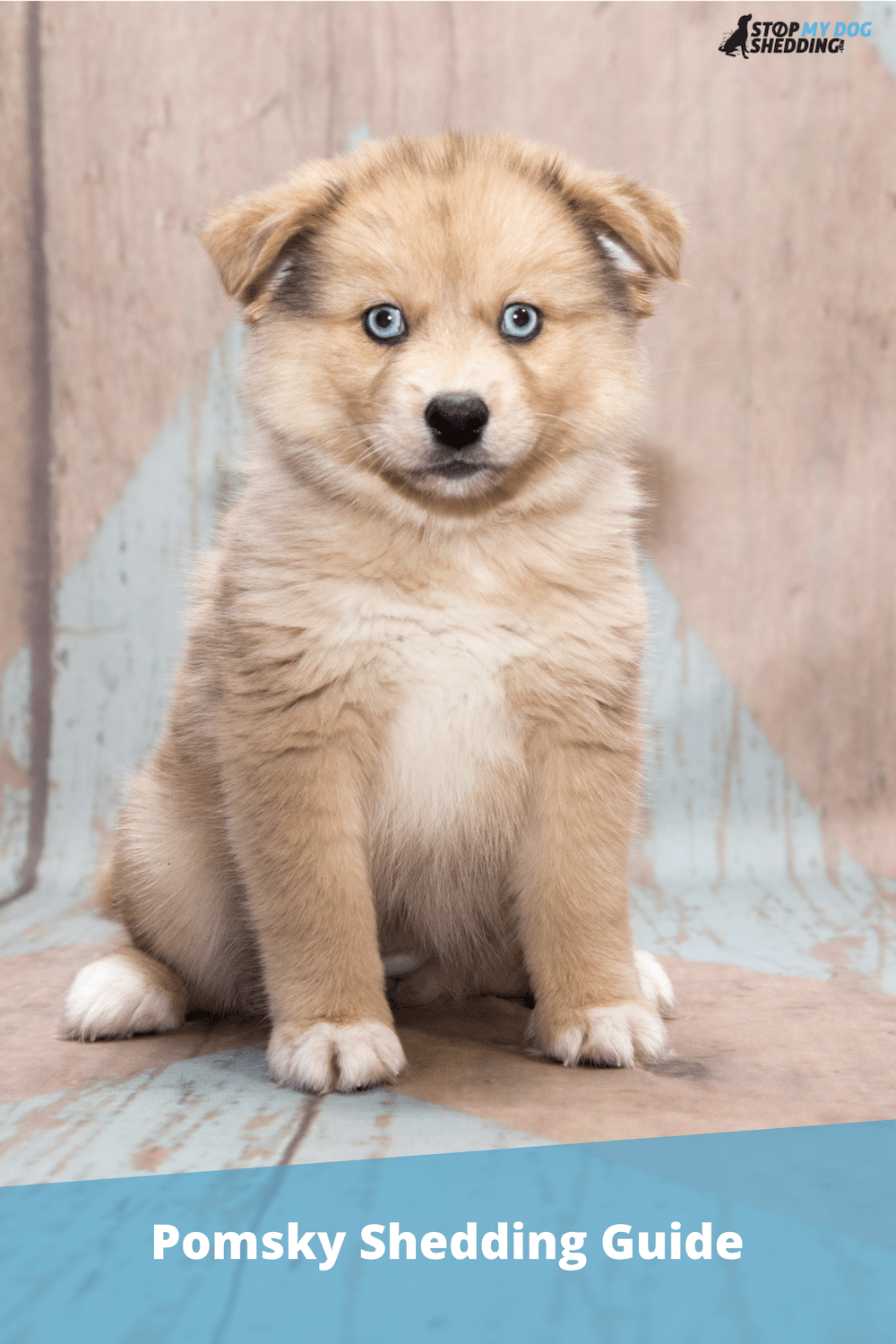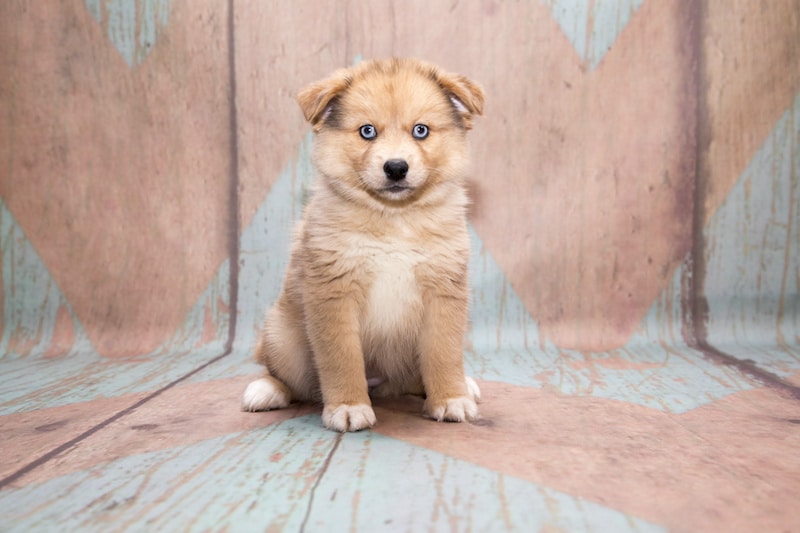Pomskies are Husky and Pomeranian crossbreeds that were created as designer dogs. With their adorable, large eyes and unique fur coloration, you might want to bring home a Pomsky too.
Just how much does the Pomsky shed?
Pomsky dogs are heavy shedders like their parents, the Pomeranian and Husky. This includes regular shedding throughout the year. Then, during seasonal changes, the Pomsky’s shedding ramps up further. Grooming a Pomsky can also be time-intensive.
I know this might not be the information you want to hear, but you should know what you’re in for if you decide to adopt a Pomsky. Ahead, I’ll talk further about this crossbreed’s rate of shedding, what grooming a Pomsky is like, and discuss how to reduce Pomsky shedding.
Pomsky Shedding
If you’ve read my other posts on hybrid dog breeds such as the Puggle, then you should know that when it comes to shedding, a crossbreed takes more after its mother or its father.
This usually means that if one parent breed has the more dominant genes and that parent doesn’t shed much, your crossbreed won’t either.
That’s not the case at all for the Pomsky.
Both its parents are moderate to heavy shedders, which means the Pomsky will be the same.
Let’s discuss both breeds individually that make a Pomsky so you can see what your Pomsky’s shedding behaviors might be like. Those are the Pomeranian and the Siberian Husky.
Pomeranians are small dogs, but they shed like the dickens.
On a scale of 1 to 5, I’d give them a 3.
Like many double-coated dogs, Pomeranians will blow their coat twice per year. The first time this happens is in the spring ahead of the summer, then again in the fall before the winter.
Even outside these two seasonal periods, Pomeranians still shed regularly, although not to quite the same degree as they do seasonally.
Since a Pomeranian isn’t a huge dog, its rate of shedding is relative. Compared to other small breeds such as the Shih-Tzu, the Pomeranian sheds mountains. Yet if you examine the Pomeranian’s shedding next to a bigger dog, its rate of fur drop doesn’t seem nearly as bad.
Don’t get me wrong, though. Pomeranians do shed quite a lot, especially for dogs of their size. Their fur is thick, and the double coat only makes it worse.
Now let’s talk about the other parent of the too-cute Pomsky, which is the Siberian Husky.
A Husky is a much larger dog than the Pomeranian. This is where the Pomsky gets its unique eye color and fur patterning from (although not all Pomskies have these features).
Huskies shed seasonally like the Pomeranian, so their double coat will make a huge mess throughout the house as it starts to come out.
Remember when I said that when it comes to a Pom’s shedding, it’s all relative? With a Husky, you’ll see how much more shedding a bigger dog can do. So get your vacuum cleaner ready, as you’re going to need it.
The thickness of a Husky’s outer coat doesn’t do the breed any favors when it comes to the dog’s propensity for shedding either.
It doesn’t matter much which parent your Pomsky takes more after. Seasonal shedding is all but guaranteed, and you can expect consistent shedding throughout the rest of the year as well.
Here’s something to take solace in; Pomskies are smaller than Siberian Huskies, so there will be less fur to go around. They’re bigger than Poms, though, so a Pomsky will shed more than them.
Grooming Your Pomsky
If you were hoping you’d at least get a break when it comes to grooming your Pomsky, that’s not going to happen. Some dog owners say that maintaining a Pomsky is like a full-time job in and of itself.
About every two to three days, you’ll have to brush your Pomsky. I recommend a bristle brush for the job.
If your Pomsky is shedding seasonally, to control their rate of blown fur, you should upgrade their brushing to every day. Keep this up until the seasonal shedding lessens.
By brushing your Pomsky’s coat, you’re collecting dead fur before it can float throughout your home.
You’re also spreading skin oils that can moisturize their skin, so your Pomsky is less likely to be dry and itchy. Scratching dry skin is a great way to lose more fur. Plus, more importantly, it can be a sign of a health issue with your dog.
When brushing your Pomsky with a bristle brush, start from the back and then make your way to the front. I know this sounds counterintuitive, but it’s the proper protocol for maintaining your Pomsky’s coat.
Each brush stroke should penetrate the thick double layer of a Pomksy’s coat to the skin. You’re not trying to scratch or rake the skin, but if you don’t brush that deep, you won’t be able to spread the skin oils.
Outside of brushing your Pomsky, you also have to bathe your dog often. Pomskies require bathing about monthly, but you might be able to wait up to three months if your dog stays inside a lot.
Due to the size of Pomskies, you can bathe yours in a sink or a tub, depending on your preferences and availability. Put a rubber mat on the surface of the sink or tub, so your pup doesn’t slip.
Use warm water to bathe your dog but ensure the water temperature isn’t scalding. Before bathing your Pomsky, consider brushing him thoroughly. Only use dog shampoo and conditioner for your Pomsky’s coat, as this can help avoid skin irritation.
If you want to heat-dry your Pomsky, use a blow dryer or hairdryer on its lowest setting. Hold the hairdryer several inches from your dog.
What about cutting your Pomsky’s coat? That’s another responsibility of dog ownership. About once every month or so, you should check your dog’s coat for mats and tangles. Trim these out as necessary with dog-grooming scissors.
When clipping any areas, remove fur a half-inch at a time. This will prevent bald spots and other unfortunate trimming mistakes that detract from the beauty of your Pomsky.
Of course, from bathing to trimming and everything in between, your groomer will gladly maintain your Pomsky if you feel like you can’t. It would be best if you still brushed your dog, though, as your Pomsky needs this done more often than those other services.
Reducing Excessive Shedding
It doesn’t matter how cute a Pomsky is; their frequent shedding can be annoying. Unfortunately, since shedding is part of your Pomsky’s DNA, you can’t make the dog stop shedding altogether. However, with the following methods, you may be able to reduce the shedding.
Grooming
I can’t stress enough the importance of regularly grooming your Pomsky.
Brushing the dog at least several times per week is the key to catching all that loose, dead fur before it ends up all over your dark-colored clothing or your new couch.
As I mentioned before, you’re also spreading oils that can combat skin dryness. Plus, as if all that wasn’t great enough, your Pomsky’s patterned coat will look shiny and feel great. You might want to pet your dog all day!
Diet
What does your Pomsky eat? If it’s store-bought dog kibble or wet food, it might be laden with preservatives.
Preservatives are empty calories that do nothing for a dog’s nutrition. Since they’re cheap and can often increase a dog food’s shelf life, they’re in many brands.
Ditch the preservatives and begin feeding your Pomsky a nutritious diet enriched with omega-3 and omega-6 fatty acids and see whether their coat improves.
Supplements with fatty acids are another way of ensuring your Pomsky has a well-rounded diet.
Bathing
Try to time your Pomsky’s bath time as his seasonal shedding spikes. Bathing, like brushing, can collect all those dead hairs before they detach from your dog.
Be sure to follow my bathing tips above. To recap, use warm but not hot water, put a mat under your dog’s feet, and always bathe your pup with dog shampoo and conditioner, not the stuff you use for your own hair.
Do not use bathing as a treatment for shedding, though. If you bathe your Pomsky (or any dog, really) too often, you’ll dry out their skin. As a result, they’ll begin shedding more.
Vet Checkups
If the above measures haven’t worked and your Pomsky is still shedding like there’s no tomorrow, then it’s time to schedule an appointment with your dog’s vet.
It could be that your Pomsky has a food allergy, a skin condition, or another undiagnosed medical issue that makes them shed more often. Whatever the cause, you want to get behind it as soon as you can.
It’s not difficult to manage dog shedding, but consistency is key, and with these tips, you should be well on your way to reducing the amount of loose fur you find floating around the home. To learn more, see our complete guide to lowering excessive shedding.
Is a Pomsky Right for You?
You might still be unsure if you should bring home a Pomsky. This section will provide more information on the history and behavior of this crossbreed so you can make up your mind.
The Pomsky is a Pomeranian and Siberian Husky luxury hybrid breed. As mentioned, the Pomsky looks like a mini Husky, usually with distinct eyes and beautiful fur patterning and coloration.
Although their personalities can vary, Pomskies are described as loving, affectionate, playful, confident, and intelligent.
The average size of a Pomsky is 15 inches tall, and the dog weighs no more than 30 pounds. Due to their size, they’re great apartment dogs. If you have a small home, a Pomsky is also an ideal companion.
And if you want to see what an adult Pomsky looks like, the following video courtesy of YouTube will show you:
That said, Pomskies are very energetic and require at least an hour of exercise per day, so you’ll need access to a dog park or another enclosed outdoor area for playing.
Pomskies will befriend other dogs and cats with proper socialization. Their lively attitude makes the Pomsky a friend of children as well. Since the dog isn’t massive, you won’t have to worry about them knocking over the kids at playtime.
Both Huskies and Pomeranians are rather vocal dogs. So more than likely, your Pomsky will bark when it wants as well. However, through training, you should be able to curb this behavior.
Recommended: Go here to see our top-rated dog hair blow dryers
Bottom Line
The Pomsky is a mix between a Siberian Husky and Pomeranian that was created for cuteness and companionship. The mid-sized dog with the Husky coloration commands attention wherever he goes, mostly for the path of hair left in his wake.
Although Pomskies are heavy shedders and they’re not very easy to maintain, grooming is the key to controlling the dog’s rate of shedding.
Be sure their diet contains an appropriate amount of healthy omega-3s and 6s, get your dog tested for allergies and skin conditions, and bathe your Pomsky monthly. These, along with the other tips I’ve mentioned, should help you reduce the shedding so that you can spend less time cleaning up loose fur and more time enjoying your sweet, smart, loving companion.













Please note: By submitting a comment using the above comment form, you confirm that you agree with the storage and handling of your data by this site as detailed in our Privacy Policy.